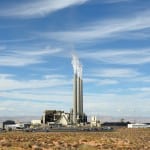The Environmental Protection Agency (EPA) on Wednesday allowed owners of the Navajo Generating Station near Page, Ariz. to consider a third option to curb nitrogen oxide (NOx) emissions that was put forth by a coalition of the plant’s stakeholders—and which proposes to keep the plant open until at lest 2020.
The 2.3-GW coal-fired power plant located near the Grand Canyon on the Navajo Indian Reservation, close to Page, Ariz., delivers more than 90% of power needed for pumping Colorado River water to central and southern Arizona for the Central Arizona Project (CAP). Meanwhile, the Navajo Nation’s economy is soundly invested on the power plant and its coal supplier, the nearby Kayenta Mine, both which support more than 1,000 private sector jobs and thousands of public sector jobs in the semiautonomous Navajo Nation government.
Citing visibility impacts to the Grand Canyon, the EPA this February proposed a Best Available Retrofit Technology (BART) rule for the Navajo plant that would require its owners—the U.S. Bureau of Reclamation and five utilities: Salt River Project (SRP), Los Angeles Department of Water & Power (LADWP), Arizona Public Service Co., Nevada Power Co. and Tucson Electric Power Co.—to install SCR technology on all three units by 2018 to reduce NOx emissions of nitrogen oxides. But according to plant operator SRP, installing SCR on all three units could cost about $544 million and exceed $1.1 billion if additional equipment is required to remove air-borne particulates created by the SCR.
Recognizing the power plant’s importance and its “unique circumstances,” the agency earlier this year also proposed an alternative that encouraged voluntary installation of low-NOx burners at the plant in exchange for an extended schedule requiring installation of SCR on one unit per year between 2021 and 2023. It also invited submittal of alternative proposals that would achieve the same or greater emissions reductions as the EPA’s proposal.
An alternative agreed on and proposed on July 26 by a Technical Working Group (TWG) made up of various interested parties would allow continued operation of the Navajo plant (until 2044), but it also takes into account commitments by the U.S. Department of Interior (DOI) to reduce carbon dioxide emissions as well as to study opportunities to transition the federal share of the Navajo plant over time, the group said.
That proposal essentially calls for closure of one 750-MW unit by January 2020 and for SCR to be installed on the remaining units by 2030—but only if the LADWP and NV Energy divest ownership in the plant as expected by 2019, and if the Navajo Nation chooses not to exercise an option to purchase a portion of the plant’s ownership shares.
The EPA on Wednesday said it conducted a “rigorous review” of the TWG alternative to ensure that it meets the requirements of the Clean Air Act before it announced the supplemental proposal to reduce emissions at the Navajo plant.
Sources: POWER, EPA, NGS
—Sonal Patel, associate editor (@POWERmagazine, @sonalcpatel)








